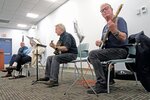Dr. Kathy Abbass doesn’t sugarcoat history or for that matter what the Rhode Island Marine Archaeology Project found in its ongoing efforts to find the HMS Gaspee.
Abbass, the driving …
This item is available in full to subscribers.
We have recently launched a new and improved website. To continue reading, you will need to either log into your subscriber account, or purchase a new subscription.
If you are a current print subscriber, you can set up a free website account by clicking here.
Otherwise, click here to view your options for subscribing.
Please log in to continue |
|


Dr. Kathy Abbass doesn’t sugarcoat history or for that matter what the Rhode Island Marine Archaeology Project found in its ongoing efforts to find the HMS Gaspee.
Abbass, the driving force behind RIMAP that has identified the remains of three frigates and 10 transport vessels from the Revolutionary War era in Narragansett Bay, was among the featured speakers at the opening of a display of artifacts and documentation of the search for the Gaspee, the British schooner that colonists led by John Brown set ablaze as she hard aground of Namquid Point the night of June 9, 1772. This display is located in the history section of the Warwick Public Library. In addition to two display cases it has two armchairs brightly upholstered with a nautical theme with a reading lamp on a small table between them. RTMAP donated the setup to the library and as Abbass explained it is a comfy corner to read and for other groups to use for exhibits.
In her remarks, Abbass said no plans for the Gaspee have been found, however, the boat is thought to have been similar in size and design to other locally British commissioned vessels at the time that would put her about 40 feet long and smaller than depicted in many paintings of the incident. Abbass speculated some of the longboats colonists used in their raid of the Gaspee were close in length to the boat set afire.
“It was a big deal,” Abbas said of the incident locally called the “first blow for freedom”, “but the vessel wasn’t big.”
Abbass offered some more of her perspective of history saying, “war is about control of resources.” As applied to the events building up to the American Revolution, she pointed out that William Dudingston had approval to take what he could from the colonists in the name of King George. Dudingston was up against highly successful Providence businessman John Brown.
Abbass suggested the only reason Dudingston took the risk of pursing the colonial ship Hannah across the shoals on Namquid Point on an ebbing tide is because he had information the boat was carrying 50 pounds sterling silver to Providence and the reason Brown rallied an estimated 80 men to rid the bay of the Gaspee and Dudingston was because “John Brown and Dudingston were both greedy bastards.”
That point of view did not diminish Abbass’ or the ardor of volunteers who undertook the search for the Gaspee in the past two years and those who funded the effort. With 2022 being the 250th anniversary of the burning, more than $40,000 in contributions were acquired to conduct a search of the point and the waters off shore. Abbass noted that at least two prior searches were conducted but no records were kept of those explorations or where they had been conducted.
For several years, RMAP has trained volunteers on how to conduct a systematic study of ship wrecks in an effort to determine their origin. Using the exposed wrecks at low tide on Greene Island in Occupasstuxet Cove and a wreck on shore, the RIMAP team took measurements, looked for artifacts and practiced a grid system of recording findings. Those same skills were employed in looking for the Gaspee both offshore and on the shore at Gaspee Point.
Rep. Joseph McNamara, a member of the RIMAP team served as master of ceremonies for the event and more. He and John Foley played their guitars and sang “Gaspee” a song written by McNamara with the chorus “Gaspee! Your captain’s nasty/you led a terror ring/for your greedy king.”
Todd Blount, president of Blount Fine Foods that was a major sponsor of the search, said the company looks at itself as entrepreneurs and what appealed to him is the “authentic and scrappy” nature of those who came together under Abbass’ leadership.
Library director Aaron Coutu said the library is a natural for the exhibit as its goal “is to connect people with information.” And Secretary of State Gregg Amore, referring to the summer-like weather, said “it’s the kind of day to go out and attack a British schooner …the American Revolution started here, not in Boston.” He presented Abbass with a Gaspee medallion that the state has made minted in preparation for the national celebration of the 250th commemoration of the Declaration of Independence.
As for the search for the Gaspee, Abbass said it will continue. She labeled the contents of the display cases that included a toy rubber shark as “trash.” But that’s not to say what may look to be beach trash could in fact be an artifact from the Gaspee. The search goes on.
Comments
No comments on this item Please log in to comment by clicking here